Most Holy Trinity Church
Most Holy Trinity Church, Montrose Avenue
William Schickel, architect
Photo: Brooklyn Public Library
Gowanus Lounge had a post a week or two back about Holy Trinity Cemetery, a small German Catholic cemetery in Bushwick (next door to the larger Cemetery of the Evergreens). The cemetery was originally located behind Most Holy Trinity Church, in Williamsburg.
Now known as Most Holy Trinity and St. Mary*, the parish was originally founded as the German Church of the Holy Trinity in 1841. It was the first National parish in the Brooklyn diocese, and the first German Catholic Church in Williamsburg. It was also the mother church for a host of other German parishes over time. Holy Trinity was founded by Father John Raffeiner, a wealthy doctor-turned-priest from Austria. Raffeiner came to the United States in 1833, settling in New York where, in 1836, he founded St. Nicholas Church on East 2nd Street (the oldest German church in the New York Diocese). Raffeiner is also credited with establishing a German parish in Boston during this period. In 1841, Raffeiner moved to Williamsburg, a village that at the time was seeing a huge influx of German emigrés. There, largely with his own funds, the priest purchased property on Montrose Avenue from Abraham Meserole.
The first church of Most Holy Trinity was a frame structure, completed in 1841. A rectory was constructed in 1844. In 1853, the parish constructed a new church building on the corner of Montrose and Graham (it was for that church that the parish's cemetery was moved). Between 1863 and 1871, Holy Trinity's parish boundaries were divided numerous times - yielding Annunciation (1863), St. Nicholas (1865), All Saints (1867) and St. Leonard's (1872) parishes. Still, the original Holy Trinity parish continued to grow, and in 1880, construction began on a new church (on the site of the original frame church). The cornerstone for the new church was laid in 1882, and the building was completed in 1885. The new church was constructed of Belleville (N.J.) brownstone, with two towers of 250' each and a 70' tall nave (the spires, also constructed of brownstone, were covered in lead sheets in 1990).
The architect for the new church was William Schickel. Schickel was active in the late 19th century; he designed a number of churches and German-related structures in New York and Brooklyn. Among his more prominent works are the Century Building on Union Square (now home to a Barnes & Noble), the Freie Bibliothek und Lesehalle on Second Avenue (now the Ottendorfer branch of NYPL) and, next door, the German Poliklinik (now the Stuyvesant Polyclinic Hospital)
Betty Smith (née Elisabeth Wehner), author of "A Tree Grows in Brooklyn" was baptized at Holy Trinity in 1897. In her novel, the church is described as "the most beautiful in Brooklyn... it was made of old gray stone and had twin spires that rose cleanly into the sky, high above the tallest tenements".
The parish's property encompasses much of the block bounded by Graham, Johnson, Manhattan and Montrose. It includes the former Catholic Orphan Asylum on Graham Avenue (erected between 1865 and 1885), two school buildings, a rectory and a faculty residence. The rectory which appears to have been constructed in 1872 (Joseph Berendach, architect), is located immediately east of the church. The elementary school is located to the east of the rectory; constructed in 1888, it was, prior to its closing in 2005, the oldest parish school in Brooklyn. The high school, which closed in 1972, was located on Johnson Avenue. In the 1880s, the church's two schools enrolled 1,600 students. The faculty residence, at the corner of Montrose and Manhattan, was designed by Beatty and Berlenbach in 1952. In addition to the buildings on its block, Holy Trinity was responsible for the construction of the original St. Catherine's Hospital, on Bushwick and Devoe.
Most Holy Trinity & St. Mary Church is just one of many significant remnants of Williamsburg's German past. The building itself, together with its associated structures, is a landmark in every sense of the word. With the recent merger of Most Holy Trinity and St. Mary, MHT's might seem secure. But its roll of parishioners (now almost exclusively Hispanic) continues to dwindle, and most of its associated structures sit vacant. With any luck, the rectory, elementary school, asylum and faculty residence will find new and compatible uses.
*Most Holy Trinity merged with Immaculate Conception of the Blessed Virgin Mary Church in 2007. St. Mary's was founded in 1841 as an Irish church, and was located at Leonard and Maujer Streets.
Sources:
Most Holy Trinity - St. Mary: History
Most Holy Trinity - St. Mary: Tour of the Church
New York Architecture Images
BushwickBK - Bushwick Geographic: Most Holy Trinity Cemetery
Smith, Betty A Tree Grows in Brooklyn
"Five Years in Building: The New and Handsome Church for German Catholics in Williamsbug." New York Times, August 24, 1885, page 8.
100th Year Marked by Brooklyn Church." New York Times, October 13, 1941, page 12.
"Catholicism: A Significant Page of Local History." Brooklyn Daily Eagle, April 1, 1877, page 4.
"Local Improvements." Brooklyn Daily Eagle, July 26, 1872, page 3.
"A New Parochial School." Brooklyn Daily Eagle, May 14, 1888, page 6.
"Building Plans Filed." New York Times, June 23, 1952, page 32.
More photos after the jump...
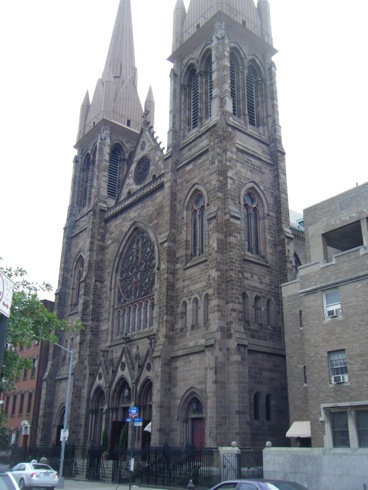
Holy Trinity Church, Montrose Avenue.
Architect: William Schickel (1882).
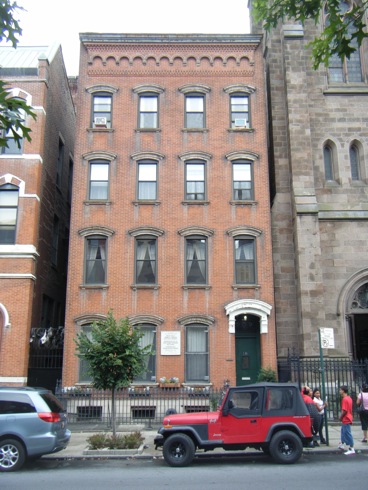
Most Holy Trinity Rectory, Montrose Avenue.
Architect: Joseph Berendach? (1872).
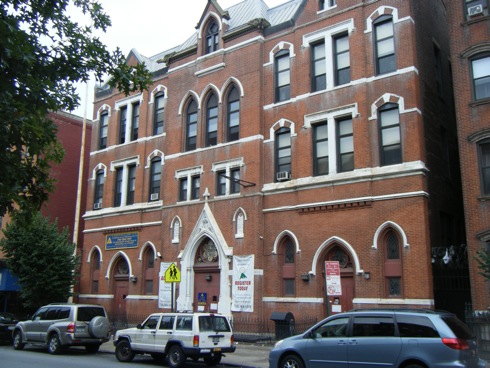
Most Holy Trinity School (1888), Montrose Avenue.
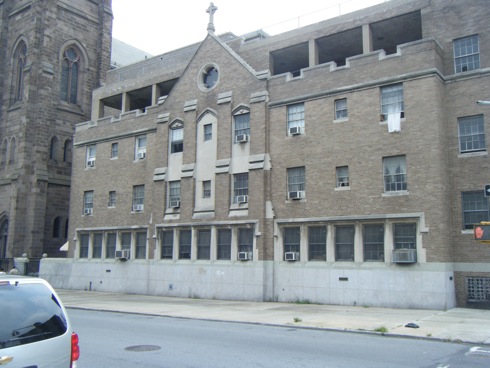
Most Holy Trinity Faculty Residence, Montrose Avenue.
Architect: Beatty and Berlenbach (1952).
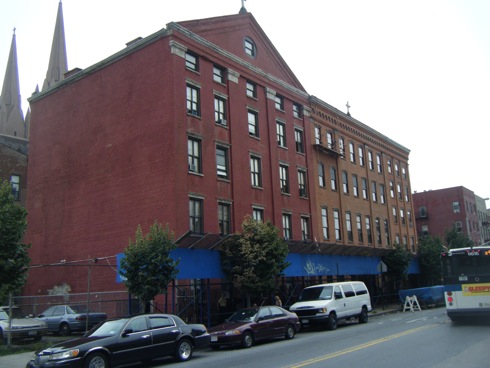
Most Holy Trinity Orphanage, Graham Avenue.
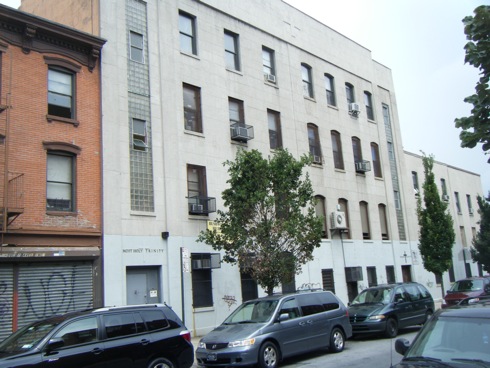
Most Holy Trinity High School, Johnson Avenue.
This building appears to have been created through the combination of two earlier buildings; note the slight change in floor heights and the difference in lintels.
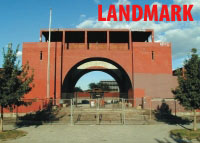
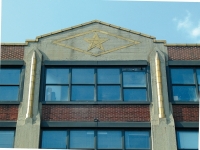
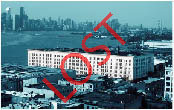
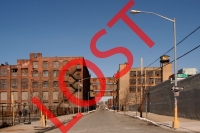

Comments (15)
I was happy to find this article posted to this site, however I believe the comment quoted below is very inaccurate.
>
Just to set the record straight:
– The recent merger of the two parishes has definitely increased the “roll of parishioners.”
– While it is true that the majority of parishioners are of Latino descent, the parish is very multi-cultural. One of its fastest growing populations consists of people of Polish descent; the parish now has a weekly Sunday Polish Mass. We have long been home to African-Americans as well as people of Western European descent. More recently we have had the opportunity to welcome some of the young professionals and “hipsters” who have arrived in the neighborhood. Our doors are open to all.
– None of our structures “sit vacant.” Much of the space occupied by the former high school now houses a very successful Head Start Program; other high school space is now home to the Trinity Human Service Center, a church-affiliated agency which provides outreach and assistance to the less fortunate. The former Most Holy Trinity Elementary School is home to Ss. Joseph and Dominic Catholic Academy, a growing Catholic grade school that unfortunately has little room for expansion. The “asylum” mentioned in the blog is actually the Most Holy Trinity S.R.O., now independent from the parish but still very much part of our institutional identity. The S.R.O. is currently undergoing a multi-million dollar renovation which will improve the building and the quality of life for its residents for many years to come. The faculty residence is occupied by a group home that serves the needs of disabled young adults. The space on the entire property is very much being used and utilized for “compatible” church related uses.
We are extremely grateful that www.wgpa.us has featured Most Holy Trinity–St. Mary on its site. May the work of the Waterfront Preservation Alliance of Greenpoint and Williamsburg continue to improve the quality of life for all of our neighbors!
Peace,
Fr. Timothy Dore, OFM Conv.
Parochial Vicar
Most Holy Trinity–St. Mary
Posted by Fr. Timothy Dore, OFM Conv. | August 16, 2008 6:45 PM
Posted on August 16, 2008 18:45
I have found out that my Great Great Grandmother is buried at the (Raffeiner)Most Holy Trinity Cemetery..back in 1881 she was buried...I have been told to be careful if I go there and that is is not a safe place...is this true. I live in Pennsylvania and want to go find her grave site. I only know that she is block 34.
theresa
Posted by Theresa Cuddy | December 30, 2008 6:41 PM
Posted on December 30, 2008 18:41
I had grown up on Leonard St. but had little contact with MHT. Attended a funeral there three years ago and was amazed at the massive architecture and the remarkable conditions throughout the structure. Very much a gem and significant for the devoted parishoners who erected this landmark 125 years ago. In the 50's & 60's the real landmark for me was the Rainbow Theater across Montrose Ave. on Graham.
Posted by Rob Tobing | January 20, 2009 10:26 PM
Posted on January 20, 2009 22:26
I've been trying to contact an old freind of mine. His name is Bartholomew Letizia. His friends called him Bobby. If anyone can give me any contact information I wouled appreciate it. He and his family were parisioners. His bithday is 10/19/1932. He is 76 years old. He went into the Airforce in 1952. Please contact me as soon as possible. My email address is marieray1225@yahoo.com
Posted by Maria Aloia | February 1, 2009 1:30 AM
Posted on February 1, 2009 01:30
I lived on Boerum Street in the 50's and I remember the Rainbow very well. As a kid I was there every Saturday afternoon.
Posted by Anonymous | June 7, 2009 1:10 AM
Posted on June 7, 2009 01:10
If this is the Bobby Letizia I once knew, I would appreciate you Emailing me @ mariealoia@yahoo.com. I would like to know how your doing. I was talking with some old friends about the Most Holy Trinity Church, when your name came up.
If you don't have a computer to e-mail then I will also leave you with my phone number 631-226-3039. It would be great hearing from you just to say "Hello", and catch up on times.
Posted by Marie Ray-Aloia | June 7, 2009 10:14 PM
Posted on June 7, 2009 22:14
I went to Most Holy Trinity elementary school from the late 40's until 1955. Sister Catherine Joseph was the principal then. I remember Father Conway, Father Abrams and Father Baretta. I use to go to the Rainbow theater with my mother and aunts on "dish night." I also remember the Lindy on Graham Ave.
Posted by Frances | June 8, 2009 1:53 AM
Posted on June 8, 2009 01:53
If anyone knows Bobby Letizia or knows how I can get in touch with him, would you please contact me. Thank You.
It would be greatly appreciated!
Posted by Marie Aloia-Ray | June 17, 2009 10:47 PM
Posted on June 17, 2009 22:47
Maria Aloia....You seem to really want to make contact with this Bobby. I think you may have better luck by giving more important information like what year you knew him and what street. It might jar someone's memory. (Just a suggestion.)
Posted by Frances | June 20, 2009 12:36 AM
Posted on June 20, 2009 00:36
Lived on Boerum St until 1960 remember Rainbow well, communion and confirmation made at Most Holy Trinity, went their Wednesday afternoons from PS 141, for religious instructions. Brings back good memories
Posted by Roseann | July 28, 2009 3:21 PM
Posted on July 28, 2009 15:21
Yes, the Rainbow, does bring back good memories. I also went to PS 141 and received communion and confirmation at Most Holy Trinity. I lived on Meserole Street then.
Posted by Maria | July 30, 2009 10:45 PM
Posted on July 30, 2009 22:45
Roseann, you lived on Boerum St. Do you remember a Bobby Letizia or the Letizia family?
Posted by Maria | July 30, 2009 10:55 PM
Posted on July 30, 2009 22:55
Roseann, I left Boerum Street in 1955. Did you live between Graham Ave. and Humbolt Street?
Posted by Frances | August 1, 2009 11:28 PM
Posted on August 1, 2009 23:28
I attended kindergarten at PS 141 (1961-62) with Miss McGroarty then changed to Most Holy Trinity. We moved out of 45 Siegel St because they were demolishing the neighborhood, which included PS 141. Can anyone share any memories of this with me? I haven't found anyone who remembers.
Posted by Jose | November 14, 2010 10:44 AM
Posted on November 14, 2010 10:44
I went to PS 141 1955-1961
Had to moved because they were tearing down all the apartment buildings and erecting the Lindsey Houses.
My teachers were Mrs. Florence Lacey, Miss Estelle Marks, Mrs. Mary Wilson, Mr. Sal Catania, Miss Bedford, Mrs Cobb
MosT Holy Trinity for catechism on Wednesday.
Rainbow on Saturday for all day show. Relocated to Ridgewood/Bushwich area
Posted by Debbie Leone | March 17, 2011 10:24 AM
Posted on March 17, 2011 10:24